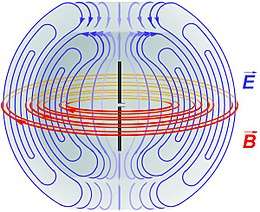Mathematics of radio engineering

Diagram of the electric fields (blue) and magnetic fields (red) radiated by a dipole antenna (black rods) during transmission.
The mathematics of radio engineering is the application of electromagnetic theory to radio-frequency engineering, using conceptual tools such as vector calculus and complex analysis.[1][2] Topics studied in this area include waveguides and transmission lines, the behavior of radio antennas, and the propagation of radio waves through the Earth's atmosphere. Historically, the subject played a significant role in the development of nonlinear dynamics.[3]
See also
References
- ↑ Blaunstein, Nathan; Christodoulou, Christos; Sergeev, Mikhail (2016-10-14). Introduction to Radio Engineering. CRC Press. ISBN 9781315350080.
- ↑ Räisänen, Antti V.; Lehto, Arto (2003). Radio Engineering for Wireless Communication and Sensor Applications. Artech House. ISBN 9781580536691.
- ↑ Israel, Giorgio (2004). "Technological Innovation and New Mathematics: van der Pol and the Birth of Nonlinear Dynamics". Technological Concepts and Mathematical Models in the Evolution of Modern Engineering Systems (PDF). Birkhäuser, Basel. pp. 52–77. doi:10.1007/978-3-0348-7951-4_3. ISBN 9783034896337.
This article is issued from
Wikipedia.
The text is licensed under Creative Commons - Attribution - Sharealike.
Additional terms may apply for the media files.